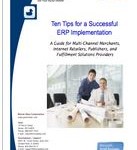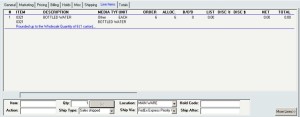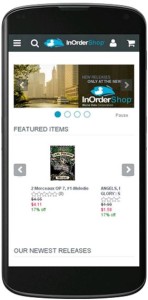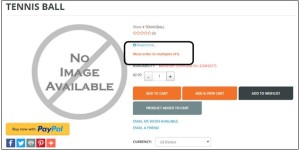Category: InOrder Software Updates
Clear Communication Between Departments Can Avoid Problems with Your ERP System
Have you ever read the stories about implementations gone wrong, or how a company upgraded an existing system without A) checking with anyone beforehand or B) telling everyone afterward?
One example is that an upgrade is completed without informing everyone in the office until the next morning, when something isn’t working properly. Another example would be someone from a Marketing Department advertising that they’re running a promotion for a product, but perhaps the promotion wasn’t added to the ERP system, resulting in an emergency fire to put out. With clear communication, marketing would send messages to to the appropriate personnel to help prevent unplanned work and avoid unhappy customers.
Communication can even help you avoid security problems, such as these. One process that might help is to appoint a team that reviews and approves any changes before they are made. This team discusses the change, its implications, and any other aspects of the business to prepare for or delay it. Another helpful tool is IT monitoring software, which alerts critical personnel, whether internal staff or an external IT service, when there is a concern.
 When planning a significant system change, it’s also important that you work hand-in-hand with your vendor’s Implementation Team (if applicable) to keep those lines of communication open to help ensure success. Our white paper, 10 Steps to a Successful Implementation, has great advice for clearly communicating change to everyone involved, as well as everyone who will be affected by the change. This advice can easily be tailored to large projects or small.
When planning a significant system change, it’s also important that you work hand-in-hand with your vendor’s Implementation Team (if applicable) to keep those lines of communication open to help ensure success. Our white paper, 10 Steps to a Successful Implementation, has great advice for clearly communicating change to everyone involved, as well as everyone who will be affected by the change. This advice can easily be tailored to large projects or small.
Remember to notify everyone of the change, and provide training and technical support as appropriate. This will help make sure the system is in the hands of qualified users.
Change doesn’t have to be painful, especially when it’s needed to help improve your system. Keeping sight of priorities, staying organized, and clear communication are key elements for successfully growing your business. We’d enjoy hearing any additional suggestions that you’ve found to be successful. Please leave your comments below.
Life After ERP Implementation
 Are you using your ERP System to its fullest advantage? Your company purchased the software, training and setup work was completed, and then it was turned on. A few years have gone by, and several updates have been made to the software. Some of the employees and even a few managers have come and gone. Few people in your department remember anything from the training, but you know the basics to get your day to day work done.
Are you using your ERP System to its fullest advantage? Your company purchased the software, training and setup work was completed, and then it was turned on. A few years have gone by, and several updates have been made to the software. Some of the employees and even a few managers have come and gone. Few people in your department remember anything from the training, but you know the basics to get your day to day work done.
Once your new system is live – and you’ve used it for a while – you may have a whole new set of needs and workflows. Equally as important as having the best technology is knowing what it can do for your business, and using it to continuously improve. Your business is constantly evolving and improving. It’s beneficial for long-time software users to evaluate how they’re using their software to determine whether improvements can be made in their processes. Here are some things to consider as you evaluate your system.
- Is your staff doing manual tasks that can be automated?
- Are you getting the most out of your web cart?
- How fast can customers find your products?
- Have your employees reverted to old processes?
This leads to frustration – and the feeling you’re stuck with something that isn’t working for you. So often, we hear “Why didn’t anyone tell us the system could do this?”
Align efficiencies with your organization’s goals
Getting the most from your ERP system means exploring, testing, and implementing new procedures and functions that maximize throughput, maximize the use of your resources, and maximize growth.
To accomplish this, you must fully understand how the system works today in your organization, as well as other ways it can potentially be configured to be used more effectively. This becomes especially important when new versions of the system become available because they include new capabilities or improvements to existing functionality.
It can be overwhelming to figure out a change strategy. Completing Annual Implementation Audits of your system and procedures can refresh the relationship between your system and your procedures. It can identify what you need, what you want, resolve annoyances, and answer questions about new features that can solve problems. Implementation Audits commonly reveal shortcuts that were not being used, and often find processes being done manually when your software could be doing them for you. You can identify functions, features, or optional modules that are not being used at all because nobody knew they existed. At this time, users and managers can attend refresher training sessions, keeping the knowledge and support of your ERP system in the hands of qualified users.
When was your last Annual Implementation Audit? When it’s time to re-align your ERP system with your processes, give us a call. Morse Data is committed to Change Management and Continuous Process Improvement. Changes can get out of line, but we can help get your ducks InOrder.
Get Your Wholesale Shopping InOrder
InOrder provides support for wholesale ordering, including wholesale orders that require items to be ordered in multiples of the item quantity per carton.
Whenever a line item is added to an order, it is checked to determine if wholesale ordering is in effect. If it is, then the quantity ordered must be a multiple of item carton quantity. The item quantity is rounded up to the carton quantity, and a line item message indicates that the line item was rounded up. A popup alert may also be displayed.
Enforcement of wholesale order requirements may be changed at the line item level. When this setting is changed on the order and one or more line items already exist, line items that are already on the order are not affected. Therefore, this setting can be temporarily bypassed by turning it off, adding the line item, and turning it on again. This allows special overrides, when necessary, at the line item level.
This feature is also supported for Electronic Order Filling and EDI orders. On the web site, the Item Details page is also designed to show a message if there are wholesale ordering requirements for the item. You can customize this message with a simple configuration setting.
For more information about wholesale shopping with InOrder, please contact sales@morsedata.com and ask for your free demo.
Morse Data Corporation Named a Multichannel Merchant Top Commerce Platform for 2017
 We are proud to announce that we have been named a Multichannel Merchant Top Commerce Platform for 2017, part of a list of leading commerce platform providers selected by the editors of Multichannel Merchant. With this listing, users can see InOrder’s featured capabilities, ideal client types, equipment and systems, contact information, and more.
We are proud to announce that we have been named a Multichannel Merchant Top Commerce Platform for 2017, part of a list of leading commerce platform providers selected by the editors of Multichannel Merchant. With this listing, users can see InOrder’s featured capabilities, ideal client types, equipment and systems, contact information, and more.
To see what makes InOrder so special, call us at 888- 667-7332 for a free demo.
Morse Data Corporation Announces Additional Support for Credit Card Processing
InOrder now includes two new payment interfaces that support tokenization. With this update, clients using InOrder can process tokenized payments through Authorize.Net CIM and TransFirst TransExpress, in addition to its other payment processing interfaces.
The new Authorize.Net Tokenization gateway interface uses Authorize.Net’s Customer Information Manager (CIM) interface. CIM requires payments to be tokenized and does not support card present processing. There is no need for existing Authorize.Net Advanced Integration Method (AIM) users to switch to the new CIM interface unless they would like to tokenize. Further, Authorize.Net merchant accounts can use AIM or CIM (existing AIM users do not need to create a new merchant account with Authorize.Net to use CIM).
With the new TransFirst – TransExpress (TXP) interface, tokenization is optional and controlled by a checkbox when setting up the merchant information in the InOrder application.
In addition to these new payment interfaces, InOrder also supports three check processing gateways and several other credit card processors, including:
Credit Cards Processing Interfaces:
- Authorize.Net AIM
- Authorize.Net CIM (Tokenization)
- Bibit / RBS Worldpay
- Bluepay
- CyberSource
- First Data
- Litle PaymentTech
- TransFirst – ePay (Legacy)
- TransFirst – TransExpress
Check Processing Interfaces:
- Authorize.Net – ACH
- Authorize.Net – ACHT
- CyberSource – ACT
- My eCheck (Check 21)
- TransFirst – TransExpress – ACH
Other Interfaces:
- PayPal
Contact us for more information about processing payments with InOrder.
Sales and Search Results – Opportunities for eCommerce with Responsive Mobile Design
A website with responsive design adjusts to the sizes of all devices shoppers are using, naturally providing optimal presentation. For a web store, the result is a single cart that functions for both PC and mobile, with a similar look and feel, regardless of device size, no longer requiring multiple web sites. This means a better shopping experience for your users, which can translate to more sales and higher search rankings.
The alternatives to responsive design are dynamic serving or maintaining a separate website for mobile shoppers. Dynamic serving uses different HTML for different types of devices, so when users search for information, results for the same site are shared between different versions of HTML. Hopefully, a mobile site using dynamic serving is set up properly; otherwise, Google might not even find the mobile content. Maintaining a separate web store for mobile shoppers is (at least) twice the work as having a single online web store. Each supported device requires a separate web site. Otherwise, it might not display properly to mobile users, increasing the number of people who leave the website after visiting only one page (raising bounce rates), and risking loss of would-be customers to frustration. If your site is awkward for mobile users, you could be decreasing your own search results and sales.
 Responsive design eliminates these concerns. It is more cost-effective and easier to manage than maintaining two separate websites, it uses the same HTML for all devices, and it provides a better experience for users who switch between devices and for those who share links to websites. It is also Google’s recommended design for all devices
Responsive design eliminates these concerns. It is more cost-effective and easier to manage than maintaining two separate websites, it uses the same HTML for all devices, and it provides a better experience for users who switch between devices and for those who share links to websites. It is also Google’s recommended design for all devices
Google can more efficiently index your website if it uses responsive design, and it isn’t necessary to redirect a URL, which doesn’t increase the time it takes to load your website. In addition, responsive design provides a better experience for all users. Font sizes have a consistent appearance, so users don’t have to work hard to see the content (no double-tapping or pinch-to-zoom necessary), and links are large enough for fingers to use accurately.
There is a lot of research to support the decision for responsive design. According to a survey by Signal, 85% of respondents plan to shop using PCs or laptops, 67% plan to browse more from phones or tablets, and 60% plan to buy more from phones or tablets than they did last year. And according to this article, 75% of adult internet users have two or more devices for online use, and 67% switch between devices them, so responsive design is a sound business decision.
For details about InOrder’s responsive mobile design, or for a demo of InOrder eCommerce, contact Morse Data Corporation.
Morse Data’s Mobile Web Uses Google’s Recommended Responsive Design
InOrder’s eCommerce module has been enhanced with a responsive design for mobile web using Google’s recommended responsive design pattern. This means that InOrder’s eCommerce web site adjusts to the sizes of all devices customers are using, naturally providing optimal presentation. A single cart functions for both PC and mobile, with a similar look and feel, regardless of device size, no longer requiring multiple web sites. This also means that your InOrder web site won’t be severely penalized in search results for not meeting Google’s responsive design recommendations.
 InOrder’s mobile cart rated 100/100 for user experience according to Google’s ratings, and 91/100 for speed, which compared competitively better than Amazon (70/100), and another website using Magento’s web cart (52/100).
InOrder’s mobile cart rated 100/100 for user experience according to Google’s ratings, and 91/100 for speed, which compared competitively better than Amazon (70/100), and another website using Magento’s web cart (52/100).
Customers with the InOrder eCommerce Module, the InOrder Mobile Cart add-on license, and Web Cart Upgrade Service will automatically receive this new version in time for the holiday shopping season. Other new features include image zoom, and easy linking to favorite social media sites (Facebook, Twitter, LinkedIn, GooglePlus, YouTube, Pinterest, Instagram, Yelp, RSS feed, and your own blog) so your customers can spread the word about your new site.
Contact Morse Data today for a demo of all the newest features.
Increase Sales and Build Customer Loyalty with Shipping Subscriptions
Customers all want free shipping. One successful approach is to sell a membership that includes free shipping for one year. Instead of saving up for larger orders to make shipping worthwhile, customers can order what they want when they want it, without thinking about shipping charges. This can be paired with the InOrder Loyalty module, so active members can also earn points, or extra points, they wouldn’t otherwise earn with each order.
InOrder offers a Subscriptions module with a membership option. Businesses typically sell these memberships for a set fee. Shipping can be free or computed at a discount to active members. InOrder will also Email renewal notices or other ads to the members offering special discounts for some or all products. Timing these discounts to go out at different intervals based on RFM is a great way to promote customer loyalty.
The folks at Stewart-MacDonald did just this, with great success. They launched a program called “StewMAX Membership.” For an annual fee, StewMAX Membership provides free standard shipping for one year on all orders to the U.S.. Stewart-MacDonald also extends their free shipping to returns, making purchases risk-free with their 100% Satisfaction Guarantee.
The findings from these programs have been surprisingly successful. Customers on blogs have mentioned that previously they would build a wish list, but under the new program they find themselves ordering any time they need something. This can lead to an increase on small same day orders to the same address, but InOrder allows you to combine shipments for members that are printed on the same day, allowing you to take advantage of the best shipping rate at the time of shipping.
Merchants using this approach have noted success in converting more one-time customers into regular long term customers. With free shipping memberships, customers are much more likely to place frequent orders, ultimately buying more than they would have otherwise, spending more, but also receiving more customer satisfaction.
InOrder Enterprise Management Software Version 9.9 is a PA-DSS Validated Payment Application
We are proud to announce that InOrder version 9.9 has been successfully validated according to Payment Card Industry Data Security Standards (PCI-DSS) Payment Application Data Security Standard (PA-DSS) v2.0, and may be used by merchants who are PCI-DSS compliant.
The PCI Security Standards require merchants and service providers that store, process or transmit customer payment card data to adhere to information security controls and processes that ensure data protection.
InOrder has been successfully revalidated annually since it was originally certified in 2012. To achieve PA-DSS validation, a report documenting software changes since the previous validation was provided to Trustwave, a PA-DSS Qualified Security Assessor (QSA) who audited compliance of the software, and submitted the report with the InOrder PA-DSS Implementation Guide to the PCI Security Standards Council. These reports are also available for our clients and their PCI-QSAs.
Trustwave is a security company that provides services and solutions that include security for compliance and risk, SpiderLabs, and managed security, as well as network, database, and application security services and products. For more information about Trustwave, please visit their website.
For more information about PCI-DSS and PA-DSS, please visit the PCI Security Standards Council website.
New InOrder RF Features – Bypass and Skip Item
Several RF processes provide lists from which items are picked or putaway one at a time. After the RF task is complete, the RF user is redirected to the list for the next item. This guides the RF user through the process with the intended path options selected by default.
The RF Bypass features allow your RF personnel to switch between two basic modes of operation, each equally useful depending on the RF task. Here is an example of how this would make your warehouse personnel more efficient:
For Inventory “Manual Putaway:” We have a large amount of inventory (in “general bin XYX”) and need to put it all away to respective bins for each SKU. When loading some of this inventory onto a cart or skid, there are two modes of operation:
- Mode A=”USER TELLS COMPUTER NEXT ITEM” – The RF device shows a list of the items to putaway. The RF user picks each item to load onto the transport device one after another until all items are loaded.
- Mode B=”COMPUTER TELLS USER NEXT ITEM” – The RF device tells the RF user the next item on the list to put away. The RF user finds the item to load onto the transport device one after another until all items are loaded.
Using security privileges, you can allow your RF users to switch between both methods. To switch from Mode A to B, the “Bypass” button is used. To switch from Mode B to A, the “Go Back” button is used. The Mode used might be based on personal preference, or it might be based on how the inventory to be arranged or handled.
When using Mode B =”Computer tells user next item,” an item may also be skipped, which moves the item to the end of the list. If the skipped item is found while the batch is still open, the item can be un-skipped, and putaway or received.
This feature may be used for all of these RF operations:
- Guided Putaway
- Manual Putaway
- Guided Picking
- Receiving
- Physical Counts
Each of these RF operations has a separate security privilege to determine which mode a user/group will automatically be in, as well as a host of privileges to control which buttons or options they get in each operation.






